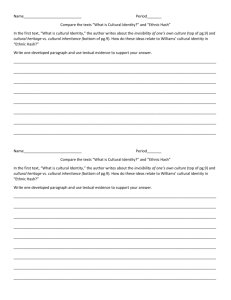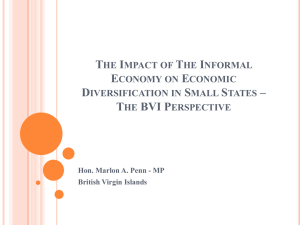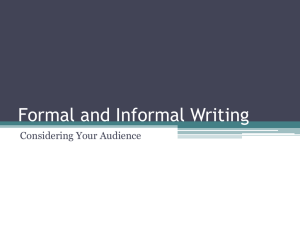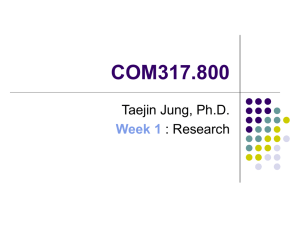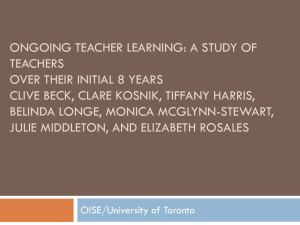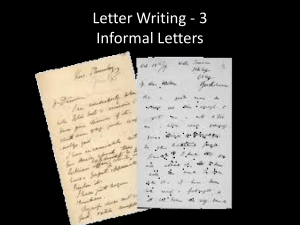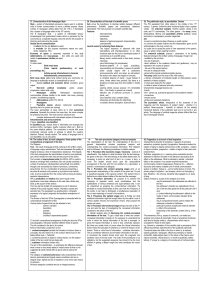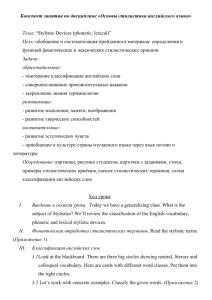File - Mrs. Manning @ OCHS
advertisement
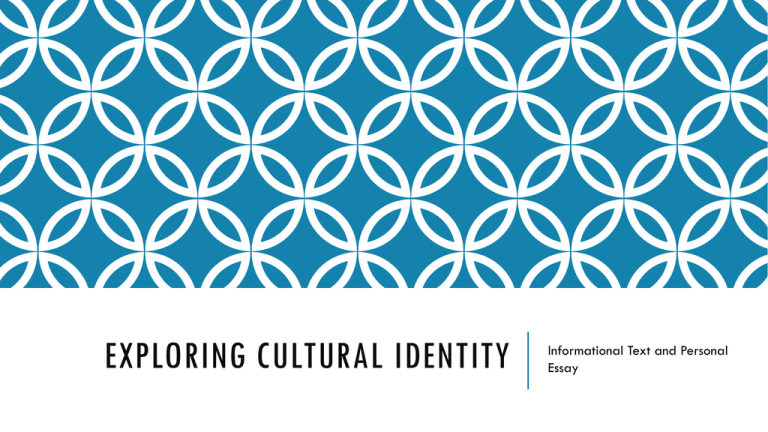
EXPLORING CULTURAL IDENTITY Informational Text and Personal Essay LEARNING TARGET FOR THIS LESSON Compare and contrast how a theme or central idea of a text is developed in an academic and a literary nonfiction text. Let’s discuss… Look at the picture. What do you notice about the photo? FORMAL VS. INFORMAL VOICE Informal voice is less professional than formal voice and should be saved for communications with family, friends, and peers. Formal writing, on the other hand, should be used when you are writing to a person or group of people with whom you are unfamiliar and whom you consider superior in rank. FORMAL VS. INFORMAL VOICE When writing in a formal voice avoid the following: Slang words – avoid words like “cool,” “dude,” “cute,” “like,” and text jargon like “lol”. Purple prose – Purple prose is a term used to describe writing that is so extravagant or ornate that the meaning of the sentence is lost. Contractions – contractions are considered to be informal and should only be used in informal writing. Second person – avoid the use of “you”. It is not wise to address your audience directly as “you” because it assumes you possess information about your audience that you don’t. Clichés – Avoid cliché sayings like “tough as nails,” “strong as an ox,” “wrong side of the tracks,” or “back in the saddle”. Conjunctions at the beginning of a sentence – Try not to start sentences with conjunctions like “And,” “Or,” “But,” or “So”. Coordinating conjunctions are meant to join words, phrases and clauses, not to begin sentences. Vague phrasing – Try to be as precise as possible. For instance, instead of saying, “a few years ago,” try to be precise and say, “three years ago”. INFORMATIONAL TEXT: “WHAT IS CULTURAL IDENTITY?” PAGE 8-10 Reminder: Voice --is the way a writer or speaker uses words and tone to express ideas as well as the writer’s persona or personality. While we read… 1.) Writers express their voice through their use of language. As we read the two texts in this activity, identify stylistic differences that establish one voice as academic and the other an informal. Look for the following: Rhetorical questions/ Inclusive pronouns (we/our)/ diverse punctuation/ active verbs/ illustrative examples 2.) As we read each text, highlight information (words/phrases) that helps to define the concept of cultural identity. AFTER READING: PAGE 10 Using the My Notes space, write a summary of each section of this text. How does each section contribute to the development of ideas about cultural identity? Be sure to note how ideas are developed and refined throughout the text. What is your understanding of cultural identity (or how has your understanding changed) based on this text? Reflect on invisible aspects of your culture. What differences exist between you and your culture? What are some examples of your culture? Explain how these aspects are dynamic. PERSONAL ESSAY: “ETHNIC HASH” PAGE 11-12 Examining the Title What is “hash”? What could the title “Ethnic Hash” mean? Make an inference. How does William’s title introduce the topic without being explicit? What makes this an effective title? PERSONAL ESSAY: “ETHNIC HASH” PAGE 11-12 Read the first two paragraphs… Identify stylistic choices the writer made that are characteristic of a more informal voice Look for the following: First person point of view/ Punctuation to create humor/ Fragments for effect/ Shifts in tone/ Vivid details and descriptions AFTER READING: PAGE 13 Aspects of Culture: language, goods, family, pastimes and family celebrations Let’s discuss… How does Patricia Williams represent her cultural identity in her essay? She uses food to develop her exploration of her cultural identity. When you hear the term “academic voice,” what come to mind? What are some conventions and stylistic features you associate with this style of writing? Primarily third person point of view, formal diction, domain specific vocabulary Many readers associate academic voice with “dull, objective, and voiceless,” but it need not be that way. Revisit “What is Cultural Identity?” to identify specific stylistic techniques the authors use to make the text both engaging and academic. The example of arranged marriages makes the text more engaging because it allows the reader to make a real-life connection to the text. AFTER READING CONT.: PAGE 13 In contrast to academic voice, many writing situations and genres call for a more informal voice. Reread the opening paragraph of “Ethnic Hash,” and identify specific stylistic elements that establish a less formal, though still highly literate, voice. Uses first-and second-person point of view. Uses casual punctuation (exclamation marks, dashes, parentheses, and ellipses). Poses a number of questions without providing direct answers. Uses casual diction in addition to more specific culinary references.

